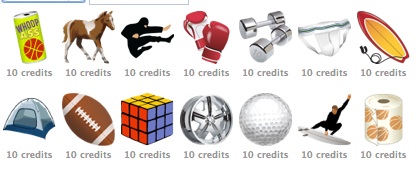
Editor’s note: Guest author Ted Sorom is the CEO of Rixty, a virtual currency platform.
The global virtual goods industry put up some very impressive numbers this year. From special Easter eggs to virtual ad campaigns, virtual goods sales have grabbed their share of headlines over the past twelve months. Now with social gaming on the rise and everyone from your teenage nephew to your grandma to your old rugby teammate buying a “little something” to sweeten their online game, here is a look a back at the year in virtual goods sales.
$7,300,000,000: expected global revenue generated by the virtual goods industry in 2010. This is huge, considering the $60 billion generated in 2009 by the video game industry as a whole, and clearly shows that browser-based gaming is making great strides.
$2,100,000,000: The projected size of the US virtual goods market in 2011.
80,000,000: the all-time high number of Farmville players. The ubiquitous title for social gaming the world over, FarmVille surpassed its 2009 high mark of 50 million monthly active users, hitting this new peak in early 2010. You can now stop pretending you’re not addicted to your precious online farm. It’s ok… you’re among friends. Oh, and now CityVille is larger than FarmVille and approaching FarmVille’s all-time high with 75 million monthly active users.
20: percentage of Electronic Art’s overall revenue generated by digital sales. These aren’t just avatar items and XP boosts; the figure also refers to full-game downloads and downloadable content (DLC) to enhance console games. EA’s CFO Eric Brown notes that their “digital sales usually start with the sale of a physical disc, especially on the current generation of consoles.” But the upcoming Star Wars MMO is guaranteed to boost DLC consumption; want a blue double-ended light saber? It can be yours, if the price is right.
90,000,000: number of Pet Society virtual goods sold every single day. According to developer EA/Playfish, their most popular title has 20 million users, double that of World of Warcraft. It’s no wonder that EA was willing to pay $400 million to acquire the hot social developer in 2009.
$635,000: New world record for the single largest purchase in an online game, in this case a virtual intergalactic resort in Planet Calypso. A few years ago the same seller, Jon ‘Neverdie’ Jacobs, sold $335,000 worth of virtual real estate in Entropia Universe. While the majority of microtransactions cost just a few dollars, there are rare occasions where individuals spend serious money on virtual goods. Clearly, the virtual “Club Neverdie superdome” was a sound investment for Jacobs; the new owner (Yan Panasjuk) anticipates that the property will continue to grow in value. He is now dedicating 40 to 60 hours a week to the game, and has been playing MMOs for over a decade. Both parties are serious about their virtual worlds. Mr. Jacobs, also a career gamer, has already made over half a million dollars in online real estate.
4,000,000: total number of items in IMVU’s virtual goods catalog, making it the world’s largest. Based in Silicon Valley, the company runs a hybrid chat, gaming and avatar site. There are over 5,000 new items added every day, primarily created and uploaded by IMVU’s own user community.
10% (and growing): percentage of overall item sales in OurWorld generated by the resale market. The multiplayer gaming destination aggregates hundreds of third-party games into a virtual world with over 16,000 virtual items. OurWorld’s CEO, Derrick Morton, states, “In the last half year, we’ve seen our resale market explode. We think that a healthy secondary market is key to running a good virtual economy. If the players can’t trade amongst themselves, the virtual goods really have no value.” Think of it as virtual Craigslist.
220,000: number of “Summertime avatar baseball caps sold in Roblox, a blocky MMO playground. These hats were available for tickets, a free currency that all players get for logging in and which can be traded for Robux or vice versa. Rest, Relaxation and Roblox: gotta keep those virtual “rays” out of your eyes!
15,000,000: number of virtual hot dogs eaten by non-playable characters in LOLapps’ Ravenwood Fair (nom nom). The Facebook game saw huge growth last year to over 100 million monthly active users (MAU), and recently released an interesting info-graphic detailing their rise. For instance, 2 billion quizzes have been taken and 8 billion gifts have been sent!
Two: the factors that drive players to buy upper-tier items in online games, as opposed to just spending $0.99 here and there. The first is Value: Net Dragon’s value packs deliver the same bulk discount that players might find in a real-world big box store. The other big factor is Rarity; limited supply drives up demand. This often comes in the form of a “box” (such as the VIP Box in GameCampus’ Shot Online golf) which contains a wide range of items plus a chance to uncover the game’s rarest and most valuable equipment.
And with that, we wish everyone a Happy New Year. By this time next year, these numbers will look small.